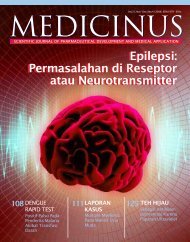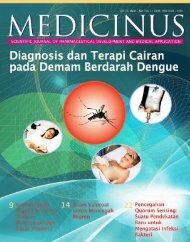Medicinus - Dexa Medica
Medicinus - Dexa Medica
Medicinus - Dexa Medica
Create successful ePaper yourself
Turn your PDF publications into a flip-book with our unique Google optimized e-Paper software.
ily inflammatory function, especially that for promoting<br />
leukocytes infiltration to endothelium. 10 This<br />
highlights the finding that the downregulation of NFkB<br />
has a link to the inhibition of atheroma formation,<br />
suggesting that DLBS1033 can be used as an antiatherogenesis<br />
agent.<br />
To confirm such finding, we observed other inflammation<br />
gene TNFα that activates NF-kB. TNFα is<br />
a cytokine that regulates many biological responses<br />
in cells, including inflammation, proliferation, differentiation,<br />
and cell death. 11 The production of TNFα is<br />
regulated by p38 MAPK through NF-kB activation. As<br />
a key mediator of inflammation, TNFα is related with<br />
the progression of IL-6 and chemokines and the adherence<br />
of leukocytes to the endothelium as well as<br />
affecting lipid metabolism. 12 This study showed that<br />
DLBS1033 decreased the expression of TNFα (Fig. 1b).<br />
It indicated that DLBS1033 can inhibit the progression<br />
of other cytokines that are activated by TNFα<br />
and adherence of leukocytes to endothelium. In the<br />
end, it will avoid the development of plaque on the<br />
endothelium.<br />
In this recent research, DLBS1033 was shown to<br />
suppress the expression of P-selectin. Previous studies<br />
suggest a causal relationship between P-Selectin<br />
and TNFα. 13-15 P-selectin is stored within endothelial<br />
cells may be recruited to the cell surface following<br />
stimulation with inflammatory mediators. 16 Those pselectin<br />
in platelets and endothelial cells mediates<br />
adhesive interaction with leucocytes to form thrombi.<br />
Surface expression of P-selectin in endothelial cells is<br />
regulated by two different mechanisms with a secretagogue<br />
and with a cytokine. Activation by secretagogue<br />
leads the translocation P-selectin to the cell<br />
surface, meanwhile the cytokine leads to de novo<br />
synthesis of P-selectin. 17 Activity of DLBS1033 in decreasing<br />
the expression of P-selectin may be related<br />
to the suppresion of de novo synthesis of P-selectin<br />
mediated by cytokine. In addition, it suggested that<br />
the suppression of NF-kB and TNFα expression leads<br />
to the decrease in the amount of of cytokines, which<br />
therefore could lead to suppression of P-selectin. That<br />
evidence supported the hypothesis that DLBS1033<br />
conferred the ability as antiplatelet agent by inhibiting<br />
the activity of P-selectin to mediate the adhesive<br />
between platelets.<br />
DLBS1033 suppressed the expression of VCAM-1<br />
(Fig. 1c), a member of the immunoglobulin gene superfamily<br />
that mediates leukocyte binding to the endothelial<br />
cell. VCAM-1 expression is rapidly induced<br />
by proinflammatory cytokines such as TNF-α. It activates<br />
endothelial cell NADPH oxidase, and this activity<br />
is required for VCAM-1-dependent lymphocyte<br />
migration. The lymphocyte migration therefore can<br />
trigger the atherosclerotic plaque formation. 18-19<br />
original article<br />
research<br />
These findings first demonstrated the mechanism of<br />
DLBS1033 in maintaining plaque stabilization that involves<br />
inflammatory response.<br />
Plaque instability is associated with high macrophage<br />
content and a thin fibrous cap. Several genes<br />
have been investigated including MMP-9 which has<br />
been known to play a role in the regulation of plaque.<br />
MMP-9 is a protease that degrades extracellular matrix<br />
proteins including gelatin, collagen, elastin, and<br />
laminin that are important in tissue destruction; and<br />
also in tissue remodeling and inflammation. 20-21 It is<br />
synthesized in atheromatous plaques and elevated<br />
levels are present in rupture prone shoulder regions<br />
of arterial vessels. Increased MMP9 activity has also<br />
been correlated with CVD, 2 since it has the capability<br />
to degrade extracellular matrix of the fibrous cap,<br />
predisposing to plaque rupture. In our research, the<br />
MMP9 was markedly suppressed by DLBS1033 (Fig.3).<br />
The expression was suppressed approximately by<br />
50% compared to that of control. MMP9 expression<br />
is regulated by transcriptional factors including AP-1<br />
and NF-kB which bind to the corresponding binding<br />
sites in MMP9 promoter region. 20 The above findings<br />
support the evidence that DLBS1033 could regulate<br />
the uncontrolled event of plaque rupture by inhibiting<br />
the expression of MMP9.<br />
DLBS1033 inhibited the proliferation of the VSMC<br />
significantly. Proliferation of VSMC is a crucial event in<br />
the formation of atherosclerotic tissues and is regulated<br />
by nuclear transcriptional factors including NF-kB.<br />
Studies have shown that diffuse intimal medial thickening<br />
is also characterized by Angiotensin II. 22-23 In<br />
this recent study, DLBS1033 significantly reduced Angiontensin<br />
II and therefore inhibits the intimal medial<br />
thickening.<br />
In addition to these findings, we observed JAK1-<br />
STAT1 system. This system plays an important role in<br />
the proliferation of VSMC. DLBS1033 decreased the<br />
expression of JAK1 (Fig. 5a) and STAT1 (Fig. 5b). JAK1 is<br />
required for myoblast proliferation and also functions<br />
as a checkpoint to prevent myoblasts from premature<br />
differentiation. Deliberate knockdown of JAK1 in both<br />
primary and immortalized myoblasts induces precocious<br />
myogenic differentiation with a concomitant<br />
reduction in cell proliferation. 24 Inhibition of JAK1<br />
phosphorylation could induce the inhibition of STAT1<br />
phosphorylation. 25 These results together indicated<br />
that DLBS1033 reduced cardiovascular events also via<br />
reducing intimal medial thickness.<br />
The investigation of DLBS1033 activity as for providing<br />
an effective mean to prevent cardiovascular<br />
disease was appeared to bring a good result. Taken<br />
together, the data shows the anti-inflammatory effect<br />
of DLBS1033 through the suppression of various<br />
genes such as NF-kB. Furthermore, the data indicates<br />
MEDICINUS 24(1), January 2011 23




